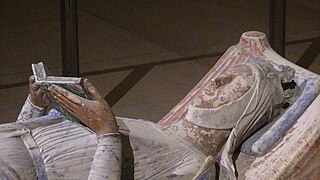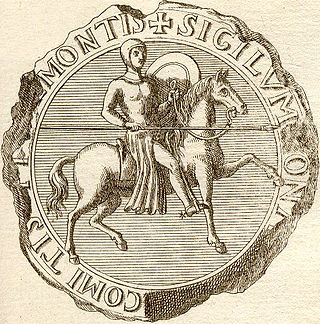
Eleanor of Aquitaine was Duchess of Aquitaine from 1137 to 1204, Queen of France from 1137 to 1152 as the wife of King Louis VII, and Queen of England from 1154 to 1189 as the wife of King Henry II. As the heiress of the House of Poitiers, which controlled much of southwestern France, she was one of the wealthiest and most powerful women in Western Europe during the High Middle Ages.

Richard I, known as Richard Cœur de Lion or Richard the Lionheart because of his reputation as a great military leader and warrior, was King of England from 1189 until his death in 1199. He also ruled as Duke of Normandy, Aquitaine, and Gascony; Lord of Cyprus; Count of Poitiers, Anjou, Maine, and Nantes; and was overlord of Brittany at various times during the same period. He was the third of five sons of Henry II of England and Eleanor of Aquitaine and was therefore not expected to become king, but his two elder brothers predeceased their father.

Louis VII, called the Younger or the Young to differentiate him from his father Louis VI, was King of France from 1137 to 1180. His first marriage was to Duchess Eleanor of Aquitaine, one of the wealthiest and most powerful women in western Europe. The marriage temporarily extended the Capetian lands to the Pyrenees.
The Lion in Winter is a 1966 play by James Goldman, depicting the personal and political conflicts of Henry II of England, his wife Eleanor of Aquitaine, their children and their guests during Christmas 1183. It premiered on Broadway at the Ambassador Theatre on March 3, 1966, starring Robert Preston and Rosemary Harris, who won a Tony Award for her portrayal of Eleanor. It was adapted by Goldman into an Academy Award-winning 1968 film of the same name, starring Peter O'Toole and Katharine Hepburn. The play has been produced numerous times, including Broadway and West End revivals.

Berengaria of Navarre was Queen of England as the wife of Richard I of England. She was the eldest daughter of Sancho VI of Navarre and Sancha of Castile. As is the case with many of the medieval English queens, little is known of her life.

Rosamund Clifford, often called "The Fair Rosamund" or "Rose of the World", was a medieval English noblewoman and mistress of Henry II, King of England. She became famous in English folklore.

Sharon Kay Penman was an American historical novelist, published in the UK as Sharon Penman. She was best known for the Welsh Princes Trilogy and the Plantagenet series. In addition, she wrote four medieval mysteries, the first of which, The Queen's Man, was a finalist in 1996 for the Best First Mystery Edgar Award.

Geoffrey II was Duke of Brittany and 3rd Earl of Richmond between 1181 and 1186, through his marriage to Constance, Duchess of Brittany. Geoffrey was the fourth of five sons of Henry II of England and Eleanor, Duchess of Aquitaine.

Arthur I was 4th Earl of Richmond and Duke of Brittany between 1196 and 1203. He was the posthumous son of Geoffrey II, Duke of Brittany, and Constance, Duchess of Brittany. Through Geoffrey, Arthur was the grandson of Henry II, King of England and Eleanor of Aquitaine, and the nephew of King Richard I of England.
Constance was Duchess of Brittany from 1166 to her death in 1201 and Countess of Richmond from 1171 to 1201. Constance was the daughter of Duke Conan IV by his wife, Margaret of Huntingdon, a sister of the Scottish kings Malcolm IV and William I.

The Duchy of Aquitaine was a historical fiefdom located in the western, central and southern areas of present-day France, south of the river Loire. Although the full extent of the duchy, as well as its name, fluctuated greatly over the centuries and at times comprised much of what is now southwestern (Gascony) and central France.

Eleanor, Fair Maid of Brittany, also known as Damsel of Brittany, Pearl of Brittany, or Beauty of Brittany, was the eldest daughter of Geoffrey II, Duke of Brittany, and Constance, Duchess of Brittany. Her father, Geoffrey, was the fourth son of Henry II, King of England.

Conan IV, called the Young, was the Duke of Brittany from 1156 to 1166. He was the son of Bertha, Duchess of Brittany, and her first husband, Alan, Earl of Richmond. Conan IV was his father's heir as Earl of Richmond and his mother's heir as Duke of Brittany. Conan and his daughter Constance would be the only representatives of the House of Penthièvre to rule Brittany.

The House of Plantagenet was a royal house which originated in the French County of Anjou. The name Plantagenet is used by modern historians to identify four distinct royal houses: the Angevins, who were also counts of Anjou; the main line of the Plantagenets following the loss of Anjou; and the Houses of Lancaster and York, two of the Plantagenets cadet branches. The family held the English throne from 1154, with the accession of Henry II, until 1485, when Richard III died.
Events from the 1170s in England.

Richard I of England has been depicted many times in romantic fiction and popular culture.

The Reckoning is a medieval historical novel written by Sharon Kay Penman published in 1991. The plot is of Wales's Llewelyn ap Gruffydd's fight to keep Wales independent of England and of the love story between the Welsh Prince and Eleanor de Montfort. In her writing, Penman presents the nobility of the period and focuses on conflict on various levels from individual conflicts to wars between countries. The novel received generally good reviews.

When Christ and His Saints Slept is a historical novel written by Sharon Kay Penman, published in 1994. It is the first of Penman's Plantagenet trilogy, followed by Time and Chance, Devil's Brood, Lionheart and A King's Ransom. In the book Penman introduces the genesis of the Plantagenet dynasty as Empress Maude battles to secure her claim to the English throne, ultimately more for her young son Henry Plantagenet, than for herself. Penman chronicles the story of cousins Maude and Stephen as they fight for England's throne.

Time and Chance is a historical novel written by Sharon Kay Penman published in 2002 and is the second volume in the Plantagenet trilogy, preceded by When Christ and His Saints Slept and followed by Devil's Brood.
William Marshal, 1st Earl of Pembroke was an Anglo-Norman soldier and statesman. He served five English kings – Henry II, his sons the "Young King" Henry, Richard I, and John, and John's son Henry III.
















